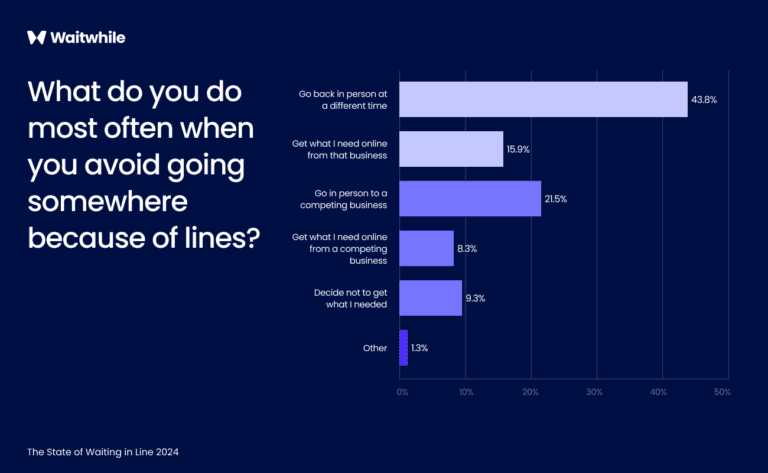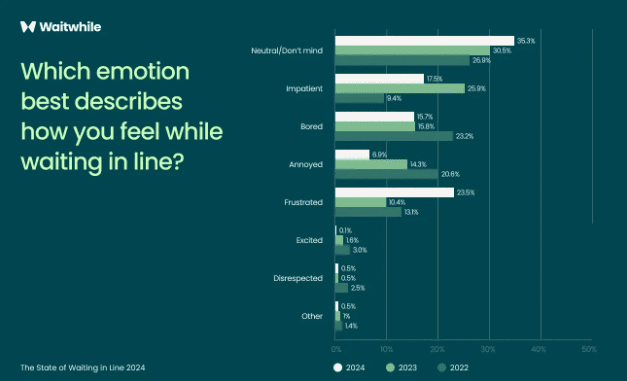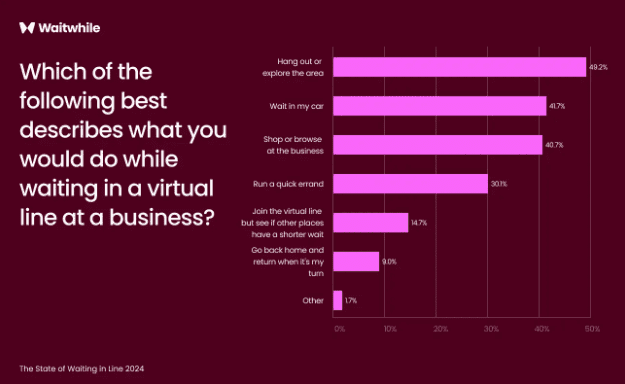How Tech Solutions Are Transforming Line Frustration into Growth


Christoffer Klemming, the CEO and co-founder of Waitwhile, explains how tech solutions have the potential to turn the frustration of waiting in lines into business growth. This article originally appeared in Insight Jam, an enterprise IT community that enables human conversation on AI.
 Emotions dominate—this is the first design principle of waiting lines. They color the experience and, more importantly, how it will be remembered. They also impact people’s judgments. Waiting may be an inescapable part of life, but that doesn’t mean we enjoy it. Nowadays, when nearly everything can be done with a few taps on a screen, long lines stand out as a glaring inefficiency. Whether it’s a crowded coffee shop, a backed-up pharmacy, or a busy government office, waiting in line creates frustration that doesn’t just end with the experience. It lingers.
Emotions dominate—this is the first design principle of waiting lines. They color the experience and, more importantly, how it will be remembered. They also impact people’s judgments. Waiting may be an inescapable part of life, but that doesn’t mean we enjoy it. Nowadays, when nearly everything can be done with a few taps on a screen, long lines stand out as a glaring inefficiency. Whether it’s a crowded coffee shop, a backed-up pharmacy, or a busy government office, waiting in line creates frustration that doesn’t just end with the experience. It lingers.
A 2023 study by PwC found that 73 percent of shoppers say experience is the most critical factor in their purchasing decisions. Despite this, long wait times remain a common—and costly—issue, driving customers to abandon purchases, switch to competitors, or rethink their loyalty altogether.
But wait times don’t just impact customers. Businesses are feeling the strain, too. Long lines create inefficiencies, overburden staff, and reduce operational capacity. This isn’t a problem for the future; it’s happening now and demands immediate solutions.
For the third consecutive year, Waitwhile conducted The State of Waiting in Line study to understand the full impact of waiting. The results reveal how deeply waiting affects consumer behavior and how technology can transform the waiting experience into an opportunity. Here’s some of what we found.
Long Waits Have High Costs

When customers encounter long waits, they walk away, sometimes for good. Research conducted by Ryan Buell, a Harvard Business School professor, emphasizes how such behavior not only affects the customer but also severely impacts the service provider’s bottom line.
According to Waitwhile’s latest survey, nearly 80 percent of consumers avoid businesses where they see or expect a line, while 40 percent will abandon their purchase or choose a competitor instead. When customers leave a queue, it’s not only a single missed transaction but also an erosion of trust and loyalty. Consumers are less likely to return to businesses where they’ve had a frustrating experience.
But the real cost goes beyond lost sales. Waiting takes a psychological toll, amplifying negative feelings like frustration and impatience. Research from Frontiers in Psychology shows that wasted time can lead to a perception of lost control, making delays feel even worse. For businesses, this means that every minute a customer waits risks immediate revenue and long-term trust and loyalty.
A Remedy for The Great Frustration

With smart queue management, businesses can turn frustration into opportunity. Technology offers solutions that make waiting shorter—or eliminate it entirely. Virtual queue systems allow customers to join a line remotely using their smartphones. Instead of standing in a physical queue, they can wait wherever they prefer, reducing frustration while giving businesses more control over customer flow.
Virtual queues are particularly effective in peak periods, offering real-time insights into demand. This enables staff to anticipate bottlenecks, optimize service times, and create a smoother overall experience. In fact, 52 percent of consumers in Waitwhile’s survey said they prefer virtual queues to traditional lines.
Appointment scheduling is another transformative solution. Nearly 70 percent of respondents said they would rather book a specific time slot than stand in line, reflecting a growing demand for predictability and personalization. Beyond improving customer satisfaction, these tools allow businesses to allocate staff and resources better, ensuring a seamless service experience even during busy times.
Turning Waiting Into a Win

One of the key drivers of emotional responses is expectation. Research shows that the memory of an event often outweighs the experience itself, which means exceeding customer expectations is critical for creating lasting positive impressions. Rather than viewing wait times as a liability, businesses can turn them into opportunities to engage customers and drive revenue. Waitwhile’s data shows that 41 percent of consumers shop or browse while waiting virtually, creating valuable moments for upselling and cross-selling.
Digital tools like personalized, location-based promotions, real-time notifications, and product recommendations can make waiting moments more engaging. A customer waiting for their turn at a bank could receive a notification about a new savings program, or a shopper at a clothing store could browse trending items while waiting for a fitting room, turning idle time into an extension of the brand experience.
Advanced queue management platforms also offer analytics that help businesses identify peak times, adjust staffing, and improve workflows. These insights ensure that every aspect of the waiting experience is optimized—not just for customers but also for operational efficiency. They also integrate with CRM systems to deliver a more personalized customer experience, such as faster service or exclusive time slots.
The future of waiting isn’t about eliminating it; it’s about rethinking it. By embracing modern tools and technology, businesses can transform wait times into opportunities to meaningfully engage, delight, and grow.



















